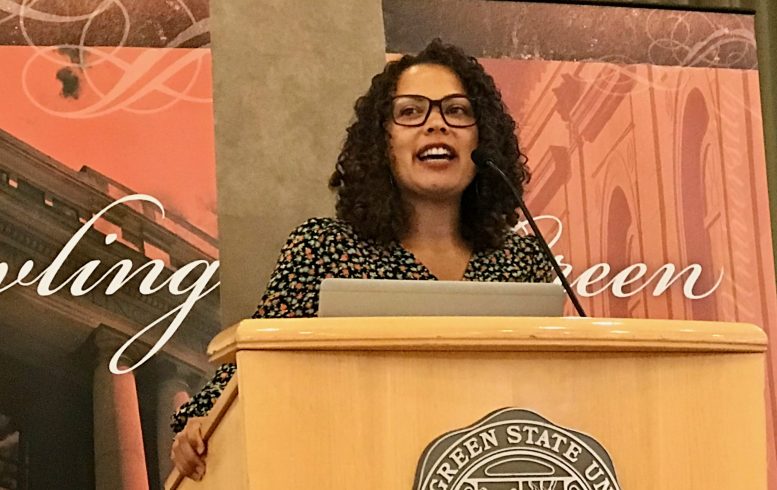By DAVID DUPONT
BG Independent News
For 60 years the percentage of female college students who report being sexually assaulted has remained constant… one in five, 20 percent.
Jessica Harris, a scholar from the University of California Los Angeles, believes that in order to address that problem, officials in higher education have to go much further back, back to the founding of the country.
Harris addressed the second Title IX Summit held last week at Bowling Green State University.
Harris along with two graduates students has analyzed 420 scholarly papers on campus sexual violence. She’s also working with 50 women of color who are victims of sexual assault.
She recognizes the problem. She recognizes the myths. She recognizes the dominant narrative. She sees the way institutions develop programs based on all of those.
She contends that’s not enough. The standard approach is ineffective.
Harris started her address by acknowledging she does not work directly with Title IX. Instead she brings a critical approach to campus sexual violence.
Those articles paint “a very, very vivid yet narrow narrative around CSA (campus sexual assault),” she said.
That focuses on white heterosexual women whose sexual identity aligns with their birth sex as the victims. Scholars eliminate those with other identities arguing their numbers of too few to be statistically valid. Even when African-American women are in the sample, data about them is not pulled out —or disaggregated — so conclusions can be made specifically about them.
The perpetrators are more likely to be male athletes and members of fraternities, Harris said.
And that begs for further study, she said: Why are these groups given so much power within campus culture?
The remedies proposed are focused on individual behavior. Individuals should intervene. Individuals should not drink alcohol to excess. Women should avoid places where they are likely to be assaulted.
A Greek alumni organization in Missouri even proposed women be banned from inside fraternities as a way of addressing the problem. That addresses the issue without “disrupting the environment within the fraternity culture by just taking women out of the culture” and tells men “‘you keep doing what you need to be doing.”
This also means “women are not able to navigate campus they way they should be able to.”
Such remedies place the burden on individuals and take it off institutions.
This does nothing to question the power on campus and who wields it whether to craft procedures and policies or to create and control campus culture.
She asked: “Who hosts party? Who controls the alcohol? Who controls who can enter spaces on and off campus?”
The University of Michigan through its Sexual Assault Prevention and Awareness Center has a program that encourages faculty and administrators and others on campus to ask questions about who holds power on campus, and in the classroom.
“Power is acting on you every single moment of your day,” she said.
This interrogation of power dynamics is especially needed in STEM fields, which have very structured hierarchies.
The Michigan center also fosters “a really beautiful dialogue on how history influences sexual assault campus,” Harris said.
From the arrival of European colonists rape was used as a weapon to terrorize indigenous populations as a way of disrupting their social order and taking their land, she said.
Virtually all colleges and universities are on land stolen from indigenous peoples. BGSU, she noted, sits on land formerly claimed by the Kickapoo, Erie, and Shawnee.
The rape of enslaved African women was both a way for slave masters to increase their human holdings, and a way to terrorize and control those they held in slavery.
Harris noted that the colleges founded in the American colonies were funded with the proceeds from the TransAtlantic slave trade.
Harvard has addressed this in a year long program confronting this sordid past.
This history has shaped the myths and perceptions that lead to the rape of women of color as less serious than the rape of white women.
In interviewing a Latina victim of groping by the two white male students, the woman said she didn’t report it because she knows these are the people who hold the power. After all, they are like the men who signed the Declaration of Independence.
Few of those she has interviewed, Harris said, reported their assaults.
“This history does map back to contemporary issues,” she said. It is seen in the light sentence given to convicted rapist Brock Turner and the way the allegations against Brett Kavanaugh were handled.
“History remains a key component,” she said. “We all are implicated within our systems.”
Harris concluded by talking about of the intersections of a person’s various identities plays into sexual assault and the ways to address it.
“Intersectionality,” Harris said, “is a buzz word.”
Though it was first introduced in 1989 by legal scholar Kimberlé Crenshaw, the concept existed long before that.
On the micro level, Harris said, individuals have a variety of identities related to gender, race, economic status, and physical ability.
On the macro level, “the system of privilege and oppression affects students with multiple identities differently,” she said. “Everyone has a different experience because of their identities.”
Different populations experience campus sexual assault in different ways. Cis men experience it differently than trans men. Men with lower socioeconomic status will experience it differently from those who are more well off.
As institutions do campus climate surveys, Harris said, they should look at all these different groups
“so we can really tailor our policies and procedures to those needs.”
This is the second year that BGSU has hosted the Title IX Summit. Jennifer McCary, chief diversity and belonging officer, said the summit gives higher education officials who work directly or indirectly with Title IX the opportunity to get together to learn more about Title IX, discuss challenges, and hear local and national experts.
McCary said 186 people representing 39 institutions had registered for the summit.

